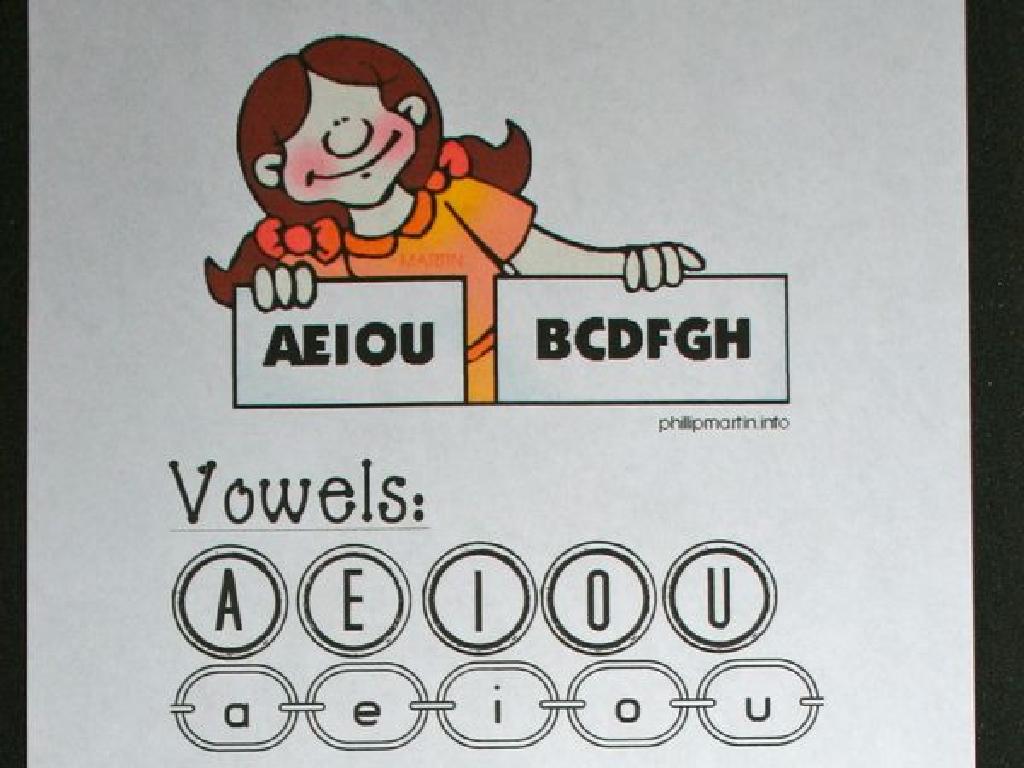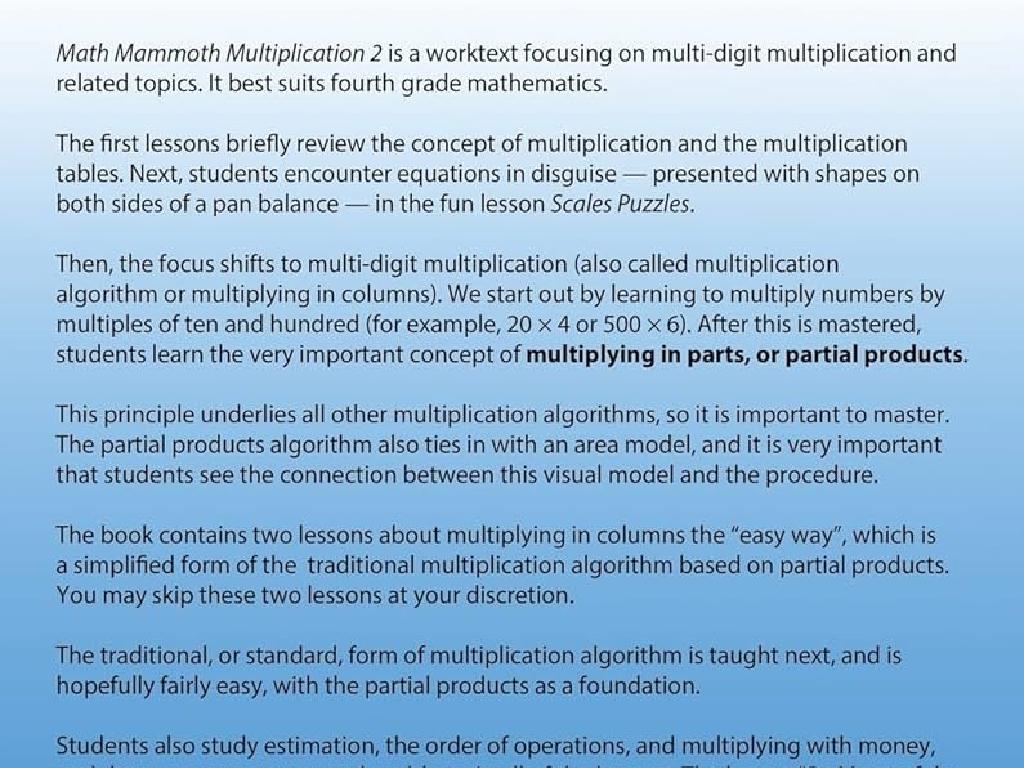Punctuation: The Colon Semicolon And More
Subject: Language arts
Grade: High school
Topic: Grammar
Please LOG IN to download the presentation. Access is available to registered users only.
View More Content
Mastering Punctuation: Colons, Semicolons & Beyond
– Punctuation shapes our writing
– It’s not just about grammar; it’s about making your writing speak.
– Focus: Colons, Semicolons, etc.
– We’ll explore uses of colons (:), semicolons (;), and other marks.
– Punctuation ensures clarity
– Misplaced punctuation can change the meaning of a sentence.
– The impact on communication
|
This slide introduces the importance of punctuation in writing, setting the stage for a detailed exploration of colons, semicolons, and other punctuation marks. Emphasize that punctuation is the key to clear and effective communication, as it helps to convey the writer’s voice and intent. Discuss how the misuse of punctuation can lead to misunderstandings or ambiguity. Provide examples of how proper punctuation can change the tone and clarity of a sentence. Encourage students to think critically about how they use punctuation in their own writing and to be mindful of the rules that govern its use.
Mastering Punctuation: The Colon
– Understanding the colon’s role
– A colon signals that what follows is an explanation or elaboration.
– Utilizing colons in lists
– For example: shopping list items, steps in a process, or series of events.
– Introducing quotes with colons
– Example: Shakespeare wrote: ‘To be, or not to be.’
– Colons leading to explanations
– Use a colon to introduce an explanation that follows an independent clause.
|
This slide aims to educate High-school students on the proper use of colons in their writing. The colon is a versatile punctuation mark used to introduce elements that expand on the information provided before the colon. When using colons in lists, it’s important to ensure that the introduction to the list is an independent clause. Colons can also introduce quotations or further explanations, providing a pause that sets the expectation for something important to follow. Encourage students to practice using colons by providing sentences that require colons for lists, quotes, and explanations. Discuss the importance of not using a colon after a verb or preposition, as this is a common mistake.
Mastering the Semicolon
– Grasping semicolon usage
– A semicolon is a punctuation mark used to connect closely related ideas.
– Linking independent clauses
– Use a semicolon between related sentences that stand on their own but are linked.
– Semicolons in lists
– When items in a list have internal commas, semicolons can separate the items for clarity.
– Enhancing writing with semicolons
|
This slide aims to deepen the understanding of semicolon usage among High schoolrs. Start by explaining the semicolon as a tool to connect ideas that are closely related but could be separate sentences. Highlight that semicolons are stronger than commas but not as definitive as periods. Provide examples of independent clauses that could be connected by a semicolon to illustrate this point. Discuss how semicolons can be used to clarify complex lists where items contain commas. Encourage students to practice using semicolons in their writing to see how it can change the flow and clarity of their sentences. Provide exercises where students can rewrite sentences using semicolons to combine related thoughts or to simplify complex lists.
Exploring More Punctuation Marks
– Understanding the dash ( )
– The dash adds emphasis or an abrupt change in thought
– Using parentheses for extra info
– Parentheses include non-essential but interesting details
– Brackets in quotations
– Brackets help clarify or add information within quotes
– Enhancing writing with punctuation
|
This slide aims to educate students on the less commonly used punctuation marks and their importance in writing. The dash is used to create emphasis or indicate an interruption or abrupt change in thought. Parentheses are used to insert additional information that is not critical to the main point but provides interesting context. Brackets are particularly useful in quotations, where the writer may need to clarify or add information to make the quote understandable in the context of their writing. Encourage students to practice using these punctuation marks in their writing to enhance clarity and expression. Provide examples of sentences that use these punctuation marks correctly and discuss how their usage affects the tone and clarity of the writing.
Mastering Punctuation: Colons and Semicolons
– Identify colons and semicolons usage
– Colons introduce lists or explanations; semicolons link closely related ideas.
– Rewrite sentences for punctuation accuracy
– Take example sentences and correct the punctuation errors.
– Engage in peer review sessions
– Exchange papers with a classmate to review punctuation use.
– Analyze and discuss punctuation choices
– Discuss why certain punctuation marks were chosen in your review.
|
This slide is focused on practical application of punctuation rules for colons and semicolons. Start by explaining the rules for using colons and semicolons, then have students practice by rewriting sentences with correct punctuation. Afterward, organize a peer review activity where students analyze each other’s work, providing a platform for discussion and deeper understanding. This interactive approach helps students learn from their peers and think critically about their punctuation choices. The teacher should facilitate the peer review, ensuring that each student gets constructive feedback. Possible activities include correcting a paragraph as a class, creating a handout with common mistakes to avoid, and using example sentences from literature or student writing.
Class Activity: Punctuation Mastery Challenge
– Break into small groups
– Create sentences with punctuation
– Use colons, semicolons, etc. from today’s lesson
– Present your best sentence
– Share with the class for feedback
– Class votes on creative use
– Consider correctness and creativity
|
This activity is designed to reinforce the use of punctuation marks such as colons and semicolons. Divide the class into small groups to encourage collaboration. Each group should create sentences that correctly use the punctuation marks discussed in today’s lesson. Afterward, groups will present their best sentence to the class. Encourage creativity and correct punctuation. The class will then vote on the sentence that demonstrates the most creative and correct use of punctuation. This activity not only solidifies the students’ understanding but also engages them in peer learning. Possible variations include using different punctuation marks for each group or creating a story with multiple sentences that use various punctuation marks.
Wrapping Up: Punctuation Mastery
– Recap punctuation rules
– Consistent practice is key
– Homework: Craft a short story
– Include various punctuation marks learned today
– Use colons, semicolons, etc.
– Focus on colons, semicolons, and integrate others
|
As we conclude today’s lesson on punctuation, it’s crucial to review the rules we’ve covered, emphasizing the importance of using punctuation correctly to enhance writing clarity and coherence. Consistent practice is essential for students to internalize these rules. For homework, students are tasked with writing a short story that incorporates colons, semicolons, and other punctuation marks discussed in class. This will allow them to apply their knowledge creatively and reinforce their learning. In the next class, we can have a few students share their stories to showcase the practical use of punctuation in writing.





